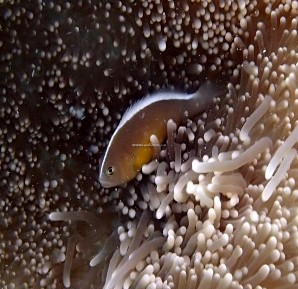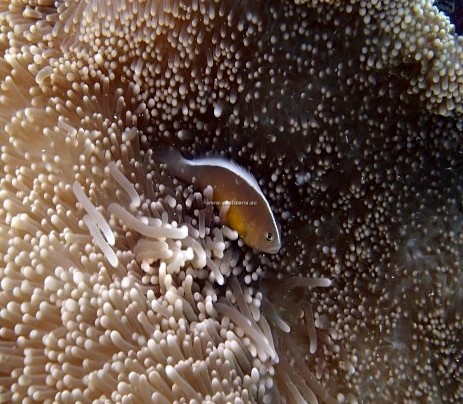Description:
Dorsal spines: 8-9; Dorsal rays: 17-20; Anal spines: 2; Anal rays: 12-14.
Light orange coloured clownfish, with a single, narrow, white stripe running from the mouth to the caudal peduncle.
Size:
Maturity: Unknown. Max length: 11.0 cm SL.
Habitat and Ecology:
Found in shallow inshore reef habitats, often in strong current zones (depth 1-25m). Protandrous hermaphrodites. Each pair is monogamous. This species is a commensal
inhabitant of sea anemones (Heteractis magnifica and Stichodactyla mertensii). Each anemone is home to a large female, a smaller functional male and several stunted juveniles; with the removal of the female, the male changes
sex and the largest of the juveniles develops into a functional male. Eggs are demersal and adhere to the substrate. Males guard and aerate the eggs.
Studies have shown that it is the female that defends the anemone using sound production, as well as a physical charge when other fishes attempt to enter. A. akallopisos
exhibit three different types of sounds, pops, short chirps, and long chirps, used depending on the type and duration of the encounter.
Fishery Status:
This species is not protected or subject to fishery regulations. It is not subject to current fishing methods.
Notes:
Photos. Courtesy and (c) 2021 of GVI/SPGA.
References:
Froese, R. & D. Pauly. Eds. (2022). FishBase. https://www.fishbase.se/summary/Amphiprion-akallopisos.html (19/06/22).
iNaturalistUK. Skunk Anemonefish (Amphiprion akallopisos). https://uk.inaturalist.org/taxa/154702-Amphiprion-akallopisos (19/06/22).
Myers, R. et al. (2017). Amphiprion akallopisos. The IUCN Red List 2017: e.T188538A1889747. https://dx.doi.org/10.2305/IUCN.UK.2017-2.RLTS.T188538A1889747.en. (19/06/22).
Citation:
Nevill, J.E.G. (2022). Amphiprion akallopisos, Skunk clownfish. Seychelles Seatizens. www.seatizens.sc. https://seatizens.sc/species/amphiprion-akallopisos-bleeker-1853/



There are no comments